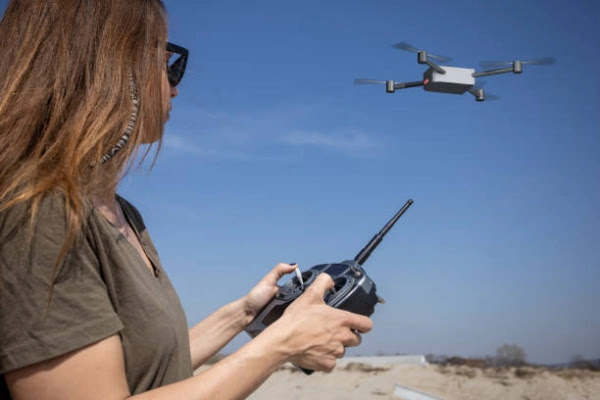Unleashing the Potential of Autonomous Drones
Revolutionizing Industries and Beyond
Introduction: Autonomous
drones, equipped with cutting-edge technologies such as artificial intelligence
(AI), computer vision, and advanced sensors, have emerged as powerful tools
with diverse applications across various industries. These unmanned aerial
vehicles (UAVs) are capable of operating without direct human intervention,
performing tasks ranging from surveillance and inspection to delivery and
mapping. This article delves into the transformative potential of autonomous
drones, exploring their impact on industries, society, and beyond.
- Applications of Autonomous Drones:
Autonomous drones are revolutionizing industries by offering innovative
solutions to complex challenges. In agriculture, drones equipped with
multispectral cameras and AI algorithms monitor crops, assess plant
health, and optimize irrigation and fertilization strategies, leading to
increased yields and resource efficiency. In construction and
infrastructure, drones conduct aerial surveys, monitor project progress,
and perform inspections of structures, improving safety, efficiency, and
cost-effectiveness. In logistics and transportation, drones facilitate
last-mile delivery of goods and supplies to remote or inaccessible areas,
reducing delivery times and costs. Moreover, in emergency response and
disaster management, drones provide real-time situational awareness,
search and rescue capabilities, and damage assessment, enhancing the
effectiveness of response efforts and saving lives.
- Advancements in Autonomous Drone
Technology: Recent advancements in autonomous drone technology have
significantly expanded their capabilities and applications. AI-powered
drones leverage machine learning algorithms to analyze data collected from
sensors and cameras, enabling autonomous navigation, object detection, and
decision-making. Computer vision technology enables drones to recognize
and track objects, identify anomalies, and navigate complex environments
with precision and reliability. Additionally, advancements in battery
technology and propulsion systems have extended the flight endurance and
range of autonomous drones, allowing them to perform longer missions and
cover larger areas. Furthermore, the miniaturization of sensors and
payloads has enabled drones to carry out specialized tasks such as
environmental monitoring, infrastructure inspection, and precision
agriculture with greater accuracy and efficiency.
- Challenges and Considerations: Despite
their transformative potential, autonomous drones face several challenges
and considerations that need to be addressed for widespread adoption.
Regulatory hurdles, including airspace regulations, privacy concerns, and
safety standards, pose significant barriers to the integration of drones
into existing airspace systems and urban environments. Moreover, technical
challenges such as limited battery life, communication bandwidth, and
environmental conditions affect the performance and reliability of
autonomous drones, particularly in remote or harsh environments.
Additionally, ethical considerations related to data privacy,
surveillance, and algorithm bias require careful attention to ensure
responsible and ethical use of autonomous drone technology.
- Future Trends and Opportunities: The
future of autonomous drones holds immense potential for innovation and
disruption across various sectors. In the transportation industry,
autonomous drone delivery services are expected to become increasingly
common, offering faster and more efficient delivery options for e-commerce
and logistics companies. In agriculture, the integration of drones with
other technologies such as precision farming, satellite imagery, and
autonomous machinery will revolutionize farming practices and crop
management. In urban planning and infrastructure development, drones will
play a crucial role in surveying, mapping, and monitoring construction
projects, enabling smarter and more sustainable urban environments.
Moreover, advancements in swarming algorithms and collaborative autonomy
will enable fleets of autonomous drones to work together on complex tasks
such as search and rescue missions, disaster response, and environmental
monitoring.
- Societal Implications and Ethical
Considerations: The widespread adoption of autonomous drones raises
important societal implications and ethical considerations that must be
addressed. Concerns related to privacy, surveillance, and data security
require robust regulations and safeguards to protect individuals' rights
and mitigate potential misuse of drone technology. Moreover, the equitable
distribution of benefits and access to autonomous drone services is
essential to prevent widening inequalities and ensure inclusive and
sustainable development. Additionally, proactive measures to address
environmental impacts such as noise pollution, wildlife disturbance, and
carbon emissions associated with drone operations are crucial for
minimizing negative externalities and promoting environmental
sustainability.
Conclusion
Autonomous drones represent a paradigm shift in how we
interact with the world around us, offering unprecedented opportunities for
innovation, efficiency, and progress. From revolutionizing industries to
enabling life-saving applications in emergency response and disaster
management, the transformative potential of autonomous drones is vast and multifaceted.
By addressing regulatory, technical, and ethical challenges and embracing
responsible and ethical practices, we can harness the full potential of
autonomous drone technology to build a safer, more efficient, and more
sustainable future for all.
